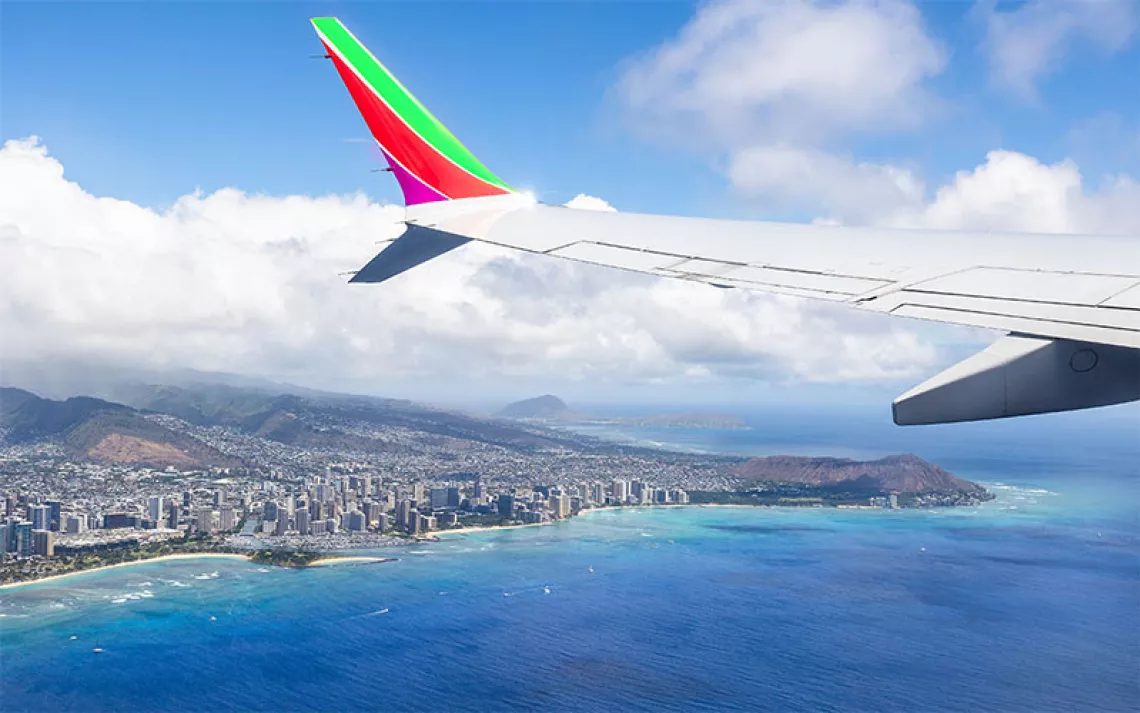The Globe-trotter’s Dilemma
Will the UN's new pact to mitigate emissions from aviation go far enough to green air travel?

Photo by anyaberkut/iStock
It turns out that flying to Cape Town, South Africa, is one of the least ecofriendly things you can do. Carbon Footprint’s calculator estimates that my roundtrip ticket from San Francisco last summer produced upward of three tons of carbon dioxide. That’s more than driving a Jeep Cherokee—named one of America’s dirtiest vehicles by Forbes—across the continental United States.
Delving into this globe-trotter’s dilemma, I grappled with a rather sobering reality: The best way to squash your carbon footprint is to go nowhere at all.
Still, the world keeps flying. Last year, nearly 3.6 billion passengers took to the skies, and that number increases annually. Beyond this season’s wave of holiday travelers, air traffic is the hallmark of our bustling, global economy—and it’s especially crucial for landlocked and island nations. From this staggering demand, the aviation industry contributes almost 2 percent of global, man-made carbon dioxide emissions.
Airplane and environmental experts alike acknowledge the need to curb this figure as part of greater climate change action. Last month, the United Nations organized an international pact—the Carbon Offsetting and Reduction Scheme for International Aviation (CORSIA)—to mitigate worldwide aviation emissions. The agreement is the first of its kind, signed by 191 member nations.
The pact aims to cap emissions at 2020 levels, which grants nations some time before restrictions finalize. As air travel is expected to increase, much of this carbon-neutral growth will manifest in the form of the availability of carbon offsets—opportunities to purchase credits in other sectors to compensate for emissions. Championed by airline companies, the agreement is chief among the UN's International Civil Aviation Organization’s “basket of measures” to reduce carbon emissions.
Dr. Olumuyiwa Benard Aliu, president of the ICAO Council, stresses that, for the industry, the agreement is both climate-action-oriented and economical. “The important financial incentives of fuel efficiency makes reduction of environmental impact an inherent reality of airline business,” he wrote in an email.
Many airline companies have already begun this streamlining process. United Airlines, for example, advertises its “four-pillar commitment to the environment” encompassing fuel-efficiency efforts, sustainable travel products, alternative fuel sourcing, and green partners. In September, JetBlue agreed to purchase more than 330 million gallons of biofuels over the next 10 years. Earlier this month, a renewable new biofuel made with Pacific Northwest forest residual wood powered a transnational Alaska Airlines flight.
Still, carbon offsets are by far the most commonplace environmental measure, both in aviation and other polluting industries. Typically offered to passengers alongside ticket purchases, these programs—opportunities to contribute to renewable energy initiatives, tree-planting projects, and other conservation efforts—carefully follow standards to ensure actual emission cutbacks.
The offsets, however, are often more complicated and controversial than their gleaming green intent conveys. For example, skeptics call into question some tree-planting initiatives, which sequester carbon dioxide initially yet are liable to release greenhouse gases when plants are burned or cut down.
Offsets also beg the question of false equivalencies—as carbon dioxide emitted at high altitudes carries greater impact—as well as whether such initiatives exist primarily to ease travelers’ guilt at the expense of motivating them to actually take a stake in future innovation and reductions. Dan Rutherford, program director of the International Council on Clean Transportation for marine and aviation, says last month’s UN agreement, which is a large-scale offsetting mechanism by nature, will not have much effect on actual aircraft emissions or increased fuel efficiency efforts.
“People are starting to think about what more can be done,” says Rutherford, who sees the pact as only a small slice of the green solution to air travel. “[Emerging technologies] could provide savings to airlines, potentially to consumers, and also contribute to the United States’ goal of carbon-neutral aviation—all in a cost-effective manner.”
For instance, a recent International Council on Clean Transportation report found that some cutting-edge new aircraft designs could reduce fuel consumption by a whopping 40 percent by 2034. However, Rutherford notes that much of the airplane manufacturing industry is currently taking the “easy route”—using existing structures and installing better engines rather than crafting entirely new frameworks.
Such findings will likely guide the EPA, which is expected to propose a greenhouse gas standard for domestic travel sometime in late 2017, according to Rutherford. (This, of course, depends on whether the Trump administration allows it to happen.) Ideally, Rutherford says, the measure could prompt airlines to consider more fuel-efficient models. Beyond national restrictions, the standard may also impact international flights landing or taking off from U.S. airports.
Travelers, however, need not wait for industry-level provisions to think about ways to lower their emissions.
Rutherford advises avoiding regional jets or smaller aircrafts and seeking out direct flights. Interestingly, coach passengers can rest assured knowing their wingprints are relatively small—flying business or first class increases an individual’s carbon footprint by three to five times (depending on seating configuration), as spacious recliners claim more space on the plane.
Frequent traveller Daniella Cheslow tried to take matters a step further. The New Jersey native, who works in Israel, says flights home were adding up—rapidly increasing her personal share in the problem. She hatched a plan to travel by barge as a low-carbon alternative. She contacted Israeli shipping company Zim, which has a route directly from New Jersey to Israel. However, the firm didn’t buy into her green voyage. They cited a slew of red flags, concluding she would need to be part of the crew, among other far-flung stipulations.
“At a certain point, I gave up,” she said. “But this idea of not flying is something I think about a lot.” Cheslow cites carpool services, like Europe-based BlaBlaCar, as an efficient way to get around.
If flying is imperative, however, studies show that choosing the most efficient airlines and routes can have a considerable effect, depending on aircraft and flight path. Though halting all air travel may be unrealistic, perusing the options before purchasing a plane ticket can make a significant greening difference. See where airlines match up on fuel efficiency, and maybe even compare routes.
Next time I’m needed across the globe, I'll certainly be vetting airlines for the most direct flight paths, the biggest coach sections, and the most efficient aircraft.
 The Magazine of The Sierra Club
The Magazine of The Sierra Club



